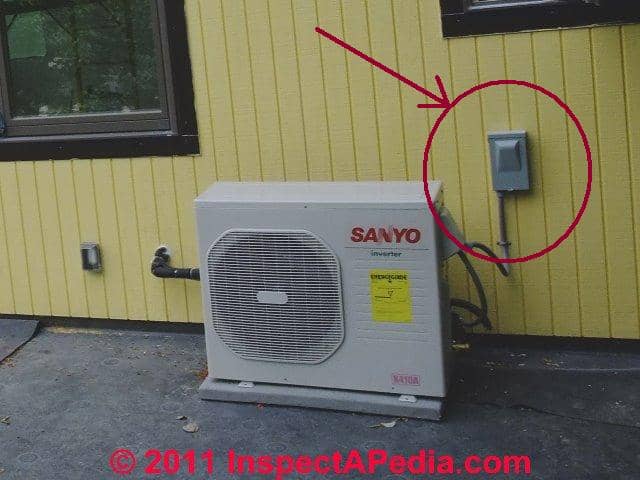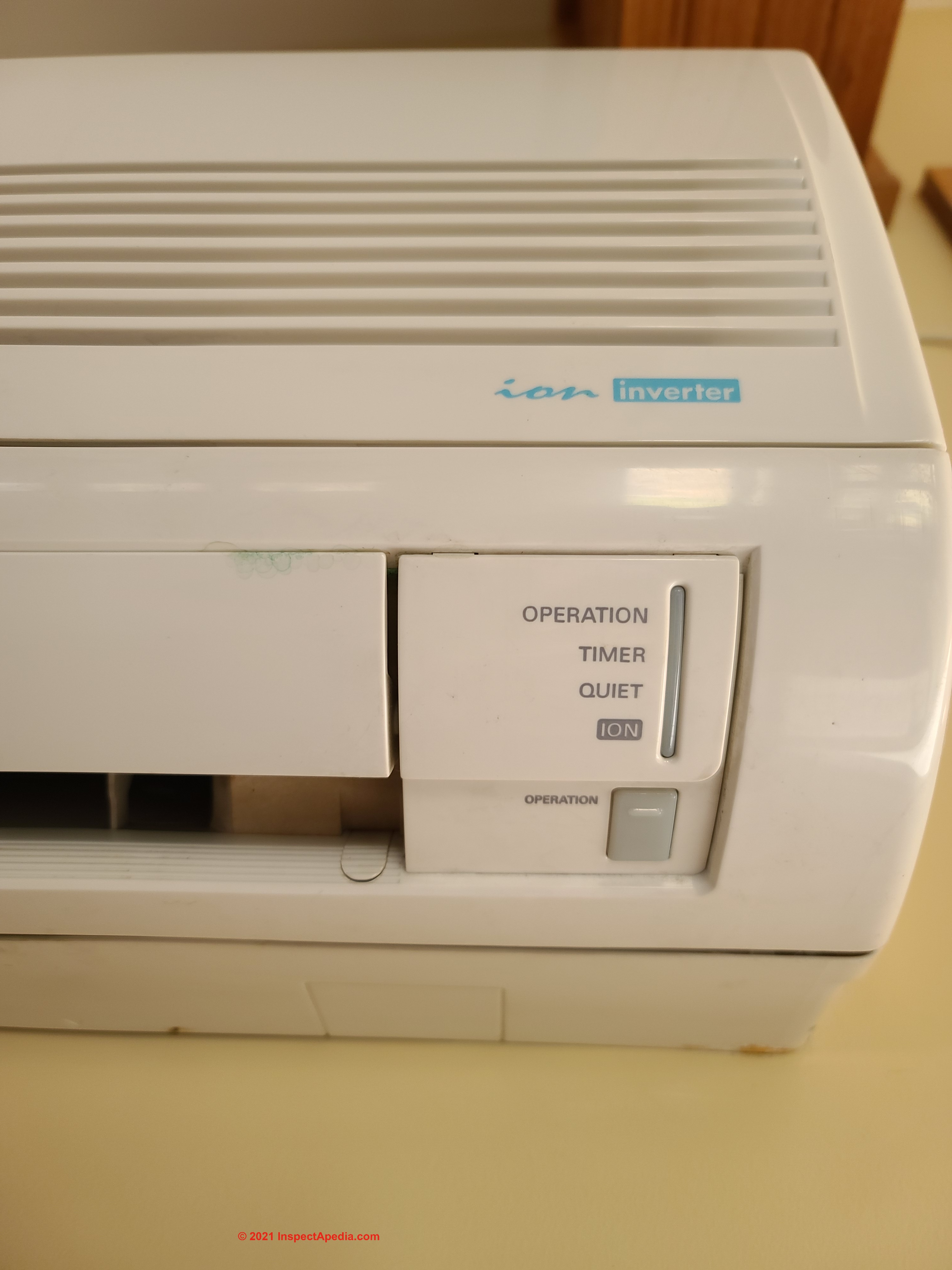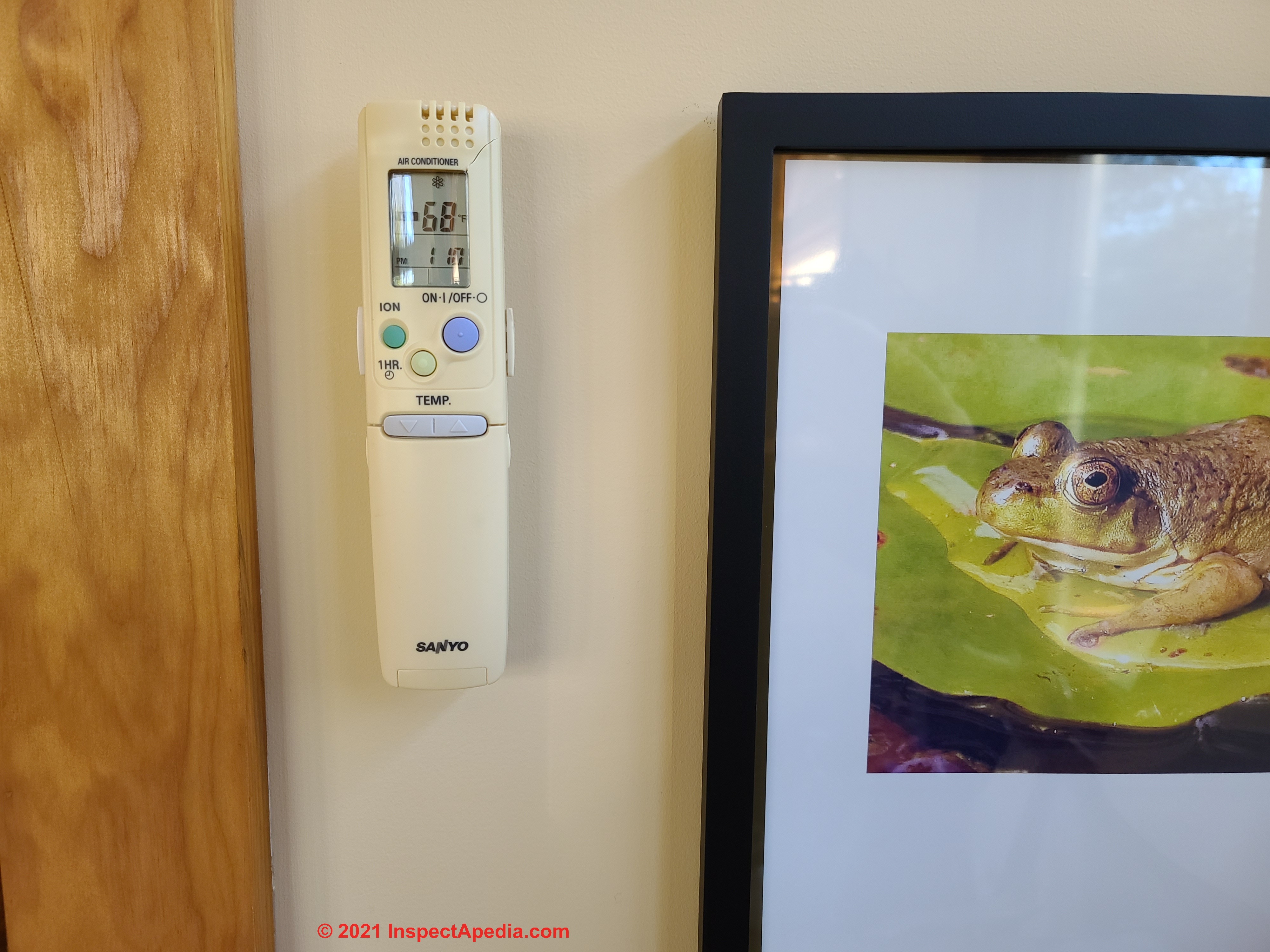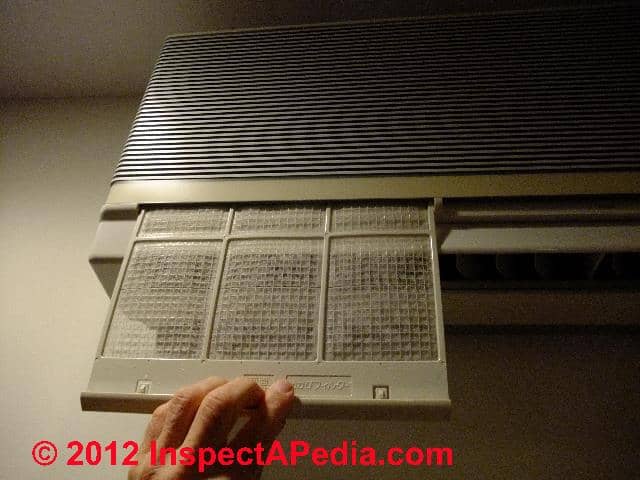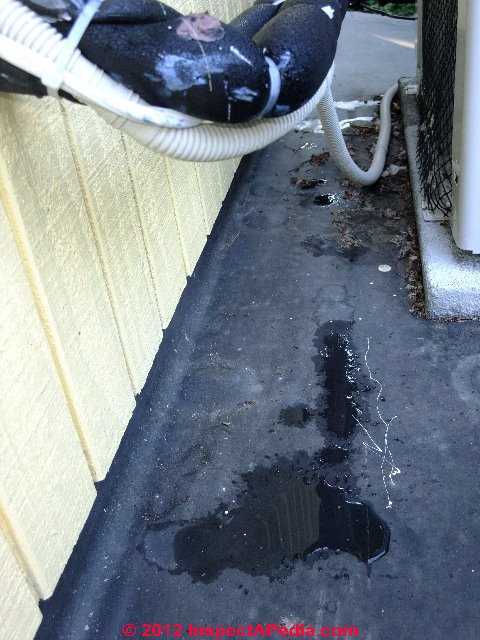 Ductless Split System Air Conditioners & Heat Pumps
Ductless Split System Air Conditioners & Heat Pumps
- POST a QUESTION or COMMENT about split system air conditioner operation, installation, maintenance, & repair
Guide to ductless split-system air conditioners:
This article describes split system air conditioning & heat pump systems. We review the major system components, switches & controls, and typical applications for split system cooling systems.
We also discuss use of the remote thermostat control, where to find and how to clean the split system air filters, how condensate is disposed-of, and what to check first if your split system air conditioner is not working properly.
InspectAPedia tolerates no conflicts of interest. We have no relationship with advertisers, products, or services discussed at this website.
- Daniel Friedman, Publisher/Editor/Author - See WHO ARE WE?
Split System Air Conditioner & Heat Pump Systems: controls, operation, diagnosis, repair & component parts guide
 A split system or "ductless" air conditioning (or A/C & heat pump) system dispenses with duct
work entirely, using a wall-mounted indoor evaporator/blower unit and a separate outside compressor/condenser (below left and right). In this
split system air conditioning design, one compressor/condenser may serve multiple wall-mount indoor units.
A split system or "ductless" air conditioning (or A/C & heat pump) system dispenses with duct
work entirely, using a wall-mounted indoor evaporator/blower unit and a separate outside compressor/condenser (below left and right). In this
split system air conditioning design, one compressor/condenser may serve multiple wall-mount indoor units.
Article Contents
- CONTROLS for Split System (Ductless) Air Conditioner Thermostats & Operating Controls
- AIR FILTER MAINTENANCE for Split System Air Conditioner - How to Clean a Split System Air Conditioner Filter
- A/C CONDENSATE DISPOSAL for Ductless or Split System Air Conditioners
- SUPPORT SAFETY WARNING for Wall-Mounted Exterior Air Conditioner / Heat Pump Compressor/Condenser Units or Window Air Conditioner Units
- DIAGNOSE WEAK AIR FLOW from a split system air conditioner or heat pump
- DIAGNOSE INADEQUATE HEATING or COOLING, SPLIT SYSTEM from a split system air conditioner or heat pump
- REMOTE CONTROL THERMOSTAT FIX or REPLACE for an air conditioners or heat pump
The ductless or split and mini-split system air conditioners used in our illustrations are Sanyo brand, but there are quite a few split system and split system mini air conditioners currently on the market, including models by Carrier, Friedrich, Frigidaire, Goodman, LG, Mitsubishi, Panasonic, Sanyo, and Samsung.
The basic components, installation, and maintenance procedures here apply to all types of mini split system or ductless A/C and heat pump units, but of course you should also read the manufacturer's installation and users' guide for your unit as well.
Split System (Ductless) Air Conditioner Thermostats & Operating Controls
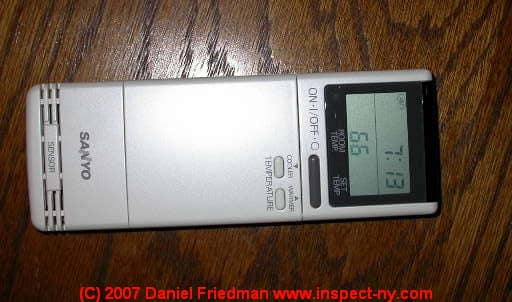 Split system air conditioners and heat pumps may use a remote control device to turn the equipment on or off and to set the desired temperature.
Split system air conditioners and heat pumps may use a remote control device to turn the equipment on or off and to set the desired temperature.
You will also find some operating switches and controls on the indoor wall-mounted cooling unit air handler, for most split system cooling units and heat pumps, the user is expected to use the remote control.
Remote control thermostats
such as the unit shown at left are usually used with air conditioning or heating split systems using an outside compressor/condenser unit and one or more indoor wall-mounted cooling or heating units..
The thermostat controls in the hand-held remote control communicates with a wall-mounted air conditioner or heater using infra red signals.
The open finned area at the bottom of the remote A/C control (at the left in our photo) permit ambient air to enter the control for purpose of sensing the air temperature.
A control such as this Sanyo (TM) unit can be quite sophisticated and include automatic set back temperatures, timers, etc.
On the remote control for a split system A/C or heat pump unit there are typically two levels of operating controls or settings.
- On the outside of the remote control device you'll see just three buttons: an on-off button and an UP and DOWN button that change the set the desired indoor temperature.
- Opening a hinged cover on the remote control for your split system air conditioner (or heat pump) you will see more extensive array of buttons and switches that allow setting the device clock, controlling the fan speed, setting an automatic setback or night time program to save energy, and for the operation of special features such as an ionizer.
- Below in this article
at SPLIT SYSTEM AIR CONDITIONERS & HEAT PUMPS-FAQs we describe troubleshooting and fixing the remote control for an air conditioner
Also see THERMOSTATS.
And at A/C - HEAT PUMP CONTROLS & SWITCHES we describe all of the controls and switches found on residential and most commercial air conditioning and heat pump systems. Other controls that affect a split system air conditioner or heat pump will include
- Main power switch, fuse, or circuit breaker in the main electrical panel or sub panel, feeding the cooling system. Often that circuit delivers power to the outdoor compressor/condenser unit and from there power is routed to the indoor wall-mounted cooling unit/air handler.
- A service switch or fuse, located outdoors at the compressor-condenser unit
You can see the outdoor service switch (circled in red) in our photo at left. Depending on the installation, this box may contain fuses, a circuit breaker, or a simple pull-out that can kill power to the unit.
If your split system A/C unit is not cooling, remember to check this switch to be sure that power is being delivered to the unit.
Watch out: at installations using aluminum wire to bring power to the outside compressor/condenser unit the electrical connections between the aluminum wire and the lugs inside the service switch can fail, leading to overheating, loss of cooling, repeated cooling outages, and even an electrical fire.
Extra care in making aluminum wire connections such as using an approved antioxidant and proper connection torquing significantly reduce this hazard. Details are
at ALUMINUM WIRING HAZARDS & REPAIRS.
How do we replace a remote control thermostat for our air conditioner?
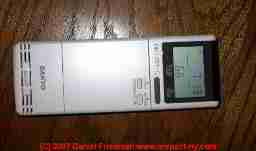 Reader questions and our reply below help troubleshoot air conditioner or heat pump remote controls.
Reader questions and our reply below help troubleshoot air conditioner or heat pump remote controls.
With regards to the Remote control thermostats, can you show us how to replace the thermostat in such a remote control? - Leanne 8/29/12
(May 8, 2014) Barbara said: I need to replace (2) remote controls for my A/C units. The model # is RCSKS09. I can't seem to find them anywhere. Any suggestions, would be appreciated.
(July 3, 2014) Karen said: I am alsolooking for a RCS-KS09 remote for AC Unit KMS 0912 and cannot locate one.
Reply: How to fix or replace a remote control thermostat control for an air conditioners or heat pump
Leanne,
A remote control air conditioner thermostat (like the one in our photo) control communicates with a wall-mounted air conditioner or heater using infra red signals.
The open finned area at the bottom of this Sanyo control (at the left in our photo) permits ambient air to enter the control for purpose of sensing the air temperature.
Barbara,
We need to add the AC brand and model information to find replacement controls or parts.Karen,
Several manufacturers sell a generic remote control that works across their product line.
Barbara replies: Sanyo Model # RCSKSO9 - thanks
Reply:
Barbara, at the following address Sanyo offers the remote control you need
us.sanyo.com/HVAC-ECO-I-VRF-Systems-Controls
A control such as this Sanyo™ unit can be quite sophisticated and include automatic set back temperatures, timers, etc. About how to diagnose and fix an air conditioner remote control unit:
(May 8, 2014) Barbara
Thank you so much for the link, but I can't find my Model # when I go to the link.
Reply:
Barbara, Sanyo says their remote works with all of their equipment. If that's not satisfactory for you then your next step is to contact the company either at
SANYO North America Corporation, a member of Panasonic Group
2055 Sanyo Avenue
San Diego, CA 92154 U.S.A.
Tel: 619-661-1134
Fax: 619-661-6795OR To find an authorized Service Center near you call 1-800-421-5013
Replacing the hand-held remote control for an A/C system:
If you mean that you need to replace the hand-held portable remote control for your air conditioner, a new unit is best bought from the manufacturer themselves as that assures complete compatability with all of your air conditioners features.
How to troubleshoot & fix an air conditioner or heat pump remote control
If you mean that you think the remote control problem is inside of the wall-mounted A/C of a split system air conditioner or heat pump then I have some different advice. Basically, since the problem is usually in the hand held control unit, start there with these diagnostic and maintenance tips:
Before digging into the air conditioner itself to troubleshoot a remote control problem I'd want to make sure that the problem was not in the remote control device itself.Check the remote control batteries:
Start with replacing the remote control's batteries, then turning it back on and testing it's ability to control the A/C unit.Watch out: a simple mistake like putting the batteries into the remote control with the (+) and (-) ends pointing the wrong way is enough to keep the control from working.
Check power to the A/C unit:
Make sure that the wall-mounted AC unit has electrical power and is on.
Next check that the off/on/auto switch on the wall-mounted A/C unit itself is in the proper run position. Usually this switch is located at a bottom corner of the unit. If someone turned the system off there, you'd think the control was inoperative.
Check remote to wall unit communication:
If the remote control is wall-mounted in a bracket (as many are), be sure that the bracket is located where the control and the A/C unit can "see" one another - by line of sight.Typically we find that when we change the set temperature on the remote control downwards, there may be a delay of several seconds before the wall unit responds, usually with a small electronic beep, an LED there may blink, and then you'll observe the blower or fan operation.
Watch out: don't cycle the system on and off rapidly in any case - the compressor can have trouble starting against a head pressure. So let the system stay "OFF" at least 3 minutes, better 15, before cycling between "off" and back "on".Some A/C systems such as the Fujitsu units will automagically prevent the system from turning back on for three minutes following any power interruption. This measure is intended to avoid rapid on-off cycling that can damage a compressor motor or blow a fuse or trip a circuit breaker.
Check internal settings on the remote control:
Make sure that you didn't accidentally set the remote control to operate the A/C system on a timer or clock control basis - or turn that feature off. (Most remote controls have simple operating buttons exposed but more detailed settings are accessed by opening the cover on the remote control device itself).Check the air sensor port on the remote control and the control resting location:
if the remote control seems to communicate with the wall unit but temperature response is not what you want, check that the openings that allow room air to enter the remote control are not blocked with dust or debris.Also consider where you are leaving the remote control. If you place the control directly in the cool air path of the A/C unit it will be "satisfied" sooner than you may wish. If you place the remote control too far away, out of the room, or in a dead air space or under a magazine, clearly it's not going to be able to respond well to the actual room temperature.
Also see THERMOSTATS, HEATING / COOLING.
Don't disassemble the wall unit to fix a remote control:
The manufacturer (using Fujitsu as an example) does NOT recommend opening the A/C unit itself to mess with the remote control sensor or hardware. The wiring and components are not generally intended for field replacement.And frankly we've rarely found that to be the location of the problem with an air conditioner or heat pump. So if none of our suggestions above worked for you, I'd call an HVAC service tech for more help.
Will my unit still work if my remote control batteries fail?
If the batteries fail in your remote will the pump shut down? - Glen 12/13/2021
Reply: Will the split system AC unit still work if remote control batteries are dead
Glen,
If the remote control for a split system air conditioner fails due to dead batteries, the air conditioner or heat pump itself can continue to function - usually under control of sensors and controls that are found right on the wall-mounted indoor air handler itself.
An example is shown below: the on-unit controls found on the indoor wall-mounted half of a Sanyo inverter A/C system.Here is the remote control for the same Sanyo inverter system. This one, of course, has live batteries - we know because we see digital data in the remote control's display.
And here is a definitive answer to your question: will the outdoor compressor/condenser unit shut down if the batteries fail in the remote-control for the split system A/C or heat pump:
No.
The following is an excerpt from the Sanyo instruction manual for the company's Split System Air Conditioner, Models KS1872 and KS2472 (2007):
Note: The remote control unit sends the temperature signal to the air conditioner regularly at five minute intervals. If the signal from the remote control unit stops for more than 15 minutes due to loss of the remote control unit or other trouble, the air conditioner will switch to the temperature sensor which is built into the indoor unit and [will continue to ] control and control the room temperature. In these cases, the temperature around the remote control unit may differ from the temperature detected at the air conditioner's position.
Split System Air Conditioner Air Filter Maintenance - How to Clean a Split System Air Conditioner Filter
Wall-mounted split system air conditioners as well as window air conditioner units include one or more removable air filters that are designed to be simply rinsed clean using cold water.
Above you can see the author replacing the left-hand air filter of a wall-mounted split system air conditioner after having washed it clean.
You can wash these plastic mesh filters in the kitchen sink using a dish sprayer but I prefer to perform the operation outdoors (shown below).
Cleaning these filters outside avoids messing up the kitchen and eliminates any risk of drain clogs.
Watch out: We have read of washable air filters that can be sent through your dishwasher. We do not recommend this step - as you risk clogging the dishwasher or its pump with dust and debris that wash off of the air filter.
We took two photos (shown below) of a pair of washable air filters pulled from the indoor cooling unit of a wall mounted split-system air conditioner used in our lab.
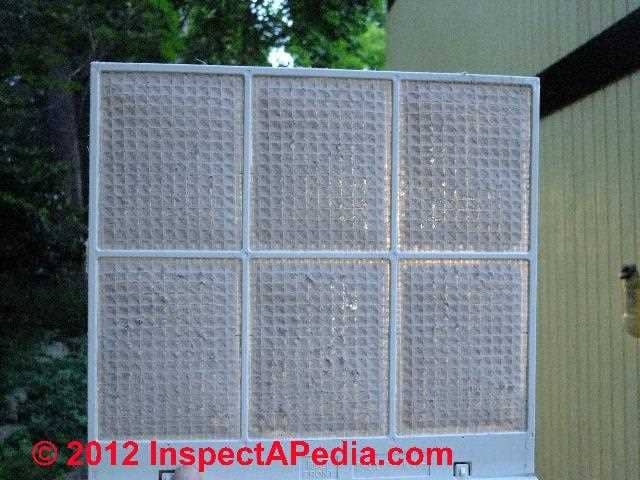
Holding up the two washable air filters and trying to peer through them, even in the dim afternoon light, that the clean filter (above) is almost transparent, while the dirty air filter (below) is completely opaque. This simple visual test can confirm the state of a washable air filter.
Watch out: these washable filters are pretty tough, but we offer these additional care recommendations:
Take care not to tear or damage the filter screen. Torn, the air filter will allow dust and debris to accumulate in the cooling system - leading to reduced cooling, frost or ice formation, and eventually the cost of a professional cleanup job.
The plastic filter is much thinner than the larger pleated paper or fiberglass filters used in the air handler of central air conditioning systems or heating furnaces.
That means the filter should be inspected and cleaned with diligence - monthly during a season of daily use would be smart.
Additional ultrafine particulate filters on some Split System A/C and Heat Pump Units
Some split system air handlers include an extra internal filter intended to reduce ultrafine particulates such as from tobacco smoke. These filters are optional and might slightly reduce the air output from the unit. Fujitsu advises as follows:
The polyphenol catechin air cleaning fi lter uses static electricity to clean fi ne particles and dust in the air such as tobacco smoke and plant pollen that are too small to see.
The filter contains catechin, which is highly effective against various bacteria by suppressing the growth of the bacteria adsorbed to the filter. Note that when the air cleaning fi lter is installed, the amount of air produced decreases, causing a slight decrease in the indoor unit’s performance. [10]
Watch out: if you take a look at this filter you'll see it looks like fragile cardboard - it is not washable but rather is a disposable filter that is replaced as needed.
Some split system air handlers also include a negative ion generation feature also intended to remove some odors and ultra fine particulates from the air flow. Quoting:
[The negative air ions feature] comprises pottery super micro particles which can produce negative air ions having the effect of deodorizing and can absorb and remit the peculiar smell at home.[10]
The negative ions system includes an internal filter sheet that should be replaced every few years. (Say 3 year intervals). [10]
A/C Condensate Disposal for Ductless or Split System Air Conditioners
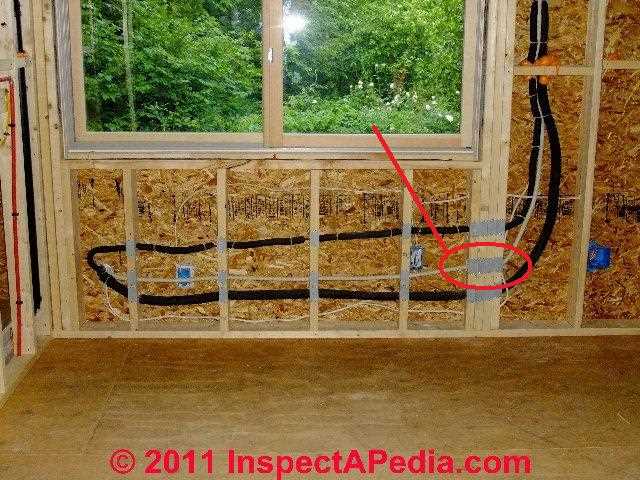
Proper slope is important for split system in-wall condensate drains
Our photo (left) shows a white flexible tube used as condensate drain tubing for a split system air conditioning system being installed in a New York Home. (click photo to see an enlarged, detailed version).
Even now the drain is not perfectly sloped (note it's a bit high at that second cripple stud from left) but it was much worse before we re-routed the drain. The air conditioner installer had the drain line sloping up-hill in the area I've circled in the photo.
Having already had condensate drain line clogs and backups and leaks from the indoor air handler into the building wall at another split-system air conditioner where the condensate drain was improperly sloped and clog-prone, I was not going to let it happen again at this installation.
The installer thought I was being unreasonably demanding.
But then, he was ignoring the plumbing code (1/8" per foot slope for condensate drain lines) and apparently didn't recognize the potential costs in rot, insect damage or mold if we simply let the condensate drain clog (due to an improper slope and dust that will enter the line) followed by leaks into the building wall up at the air handler.
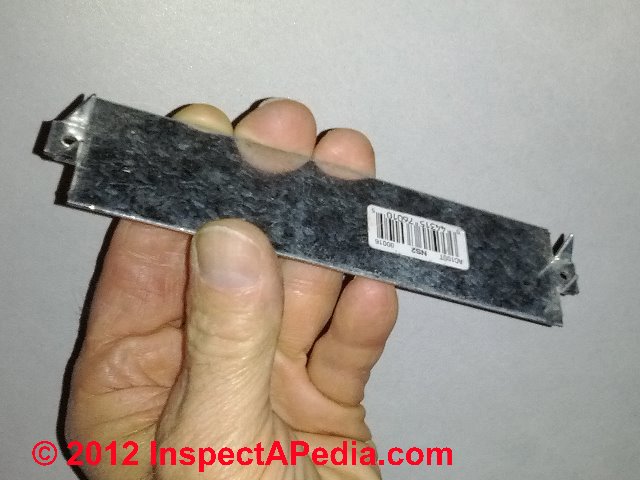
The condensate drain line and refrigerant tubing (black-insulated in the photo) were installed and the wall was prepared for blown-in insulation.
Once the wall was insulated and drywall was installed, repairing an improperly-sloped drain line would have been much more costly and disruptive.
You'll see that we also installed nail plates (Nail Stops) to protect the condensate drain and refrigerant tubing from being punctured by screws or nails to be used when the drywall was installed.
A closeup of Simpson Strong-Tie's NS2 6-inch nail stop (Protecting Shield Plate Nail Stoppers) is shown at left.
We use nail stops to protect electrical wiring as well as plumbing piping from nail or screw punctures. [6]
See ELECTRICAL OUTLET, HOW TO ADD & WIRE

Our photo at left shows the termination of the condensate drain line for this spit system air conditioner.
The white plastic flexible tubing ran through the building wall, was tied to the refrigerant lines behind the Sanyo inverter unit (compressor condenser unit) and then allowed to fall freely onto the rubber roof where condensate drains off the roof and into a gutter and downspout system for final disposal.
Since this system is a cooling-only unit, it does not operate in winter and we were thus not worried about the risk of freeze-up of the condensate disposal drain line.
at INSTALLING INSULATION ON AIR CONDITIONING & HEAT PUMP REFRIGERATION LINES
we describe how insulation should be installed on the refrigeration lines both inside the building (and in building walls or other cavities) and outside at the compressor/condenser or A/C inverter unit.
For A/C compressor/condenser (inverter) outdoor units that are mounted above ground on the building wall, also
see PROPER SUPPORT FOR WALL-MOUNTED EXTERIOR AIR CONDITIONER / HEAT PUMP COMPRESSOR/CONDENSER UNITS
Installing Insulation on Air Conditioning & Heat Pump Refrigeration Lines & Condensate Drains
Avoid gaps and missing insulation along the refrigeration lines
Proper placement and securing of insulation on air conditioner or heat pump refrigeration lines is important to avoid condensation leaks into the building. One, or on some systems both refrigeration lines can be cool or cold under some operating conditions.
In our photo above, see the drip stains below the condensate lines at each location where the insulation was compressed by a too-tight plastic tie.
The cold copper tubing in contact with warm humid air causes moisture in the air to condense onto and then drip off of the refrigeration lines.
Our photograph illustrates the importance of not compressing refrigeration insulation.
That same accumulation of water in a wall or ceiling inside which the dew point may be reached on the refrigeration lines is asking for a costly mold, insect, or rot damage problem later on. The result can be leaks into the building, as our photo illustrates below.
The drip stains on the attic floor may well indicate a point at which leak stains or even mold appear on the ceiling below.
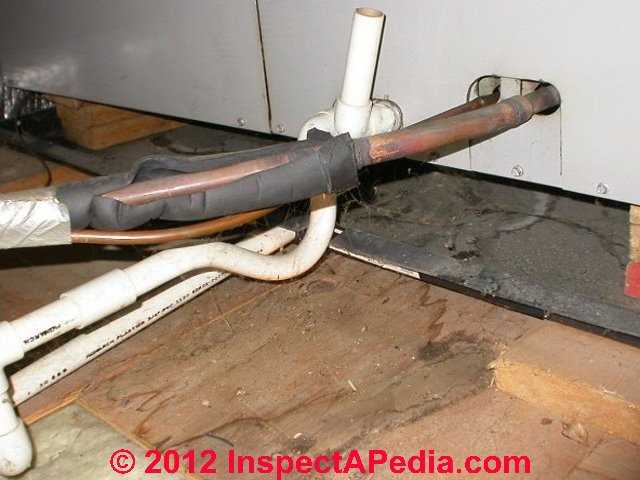
Missing insulation on the refrigeration lines outdoors is not a catastrophe - at least for a short un such as at this split system compressor/condenser unit. Perhaps a little loss in efficiency of the system operation in some weather conditions.
On a long refrigeration line run, say between an attic air handler and a ground level compressor/condenser, the effects may be more significant.
Details about refrigeration piping insulation are provided
at REFRIGERANT PIPING INSULATION
Interior Leaks On & In Wall Below a Split System Air Conditioner Wall-Mounted Unit
Watch out: The same split system air conditioner installer we described above
at A/C CONDENSATE DISPOSAL FOR SPLIT SYSTEM AIR CONDITIONERS violated the manufacturer's recommendations against compressing the insulation on the refrigerant lines not just outside or in the walls, but also inside the wall-mounted unit itself.
During the first season of use of the newly-installed Sanyo split system air conditioner the building occupants noticed water stains and rippled wall paint extending down the wall below the indoor air handler cooling unit.
Our photo (left) shows where the refrigerant lines rise in the wall to enter the wall-mounted half of the split system air conditioner (that larger white area below the left end of the unit) and the blue tape marks where we first saw condensate water dripping from the unit.
We found that there was no insulation whatsoever on the refrigeration lines that ran horizontally along the rear bottom of the unit. The result was condensation on the refrigeration lines that did not drip into the unit's condensate tray but rather fell into the plastic bottom where water leaked out onto and into
The "fix" for this condensate leak was the installation of foam insulation along the refrigerant lines inside the unit, from their point of exit from the building interior wall surface to their point of connection to the cooling coil.
Details about how we found and fixed this condensate leak from the air handler are at
at REFRIGERANT PIPING INSULATION.
Support for Wall-Mounted Exterior Air Conditioner / Heat Pump Compressor/Condenser Units
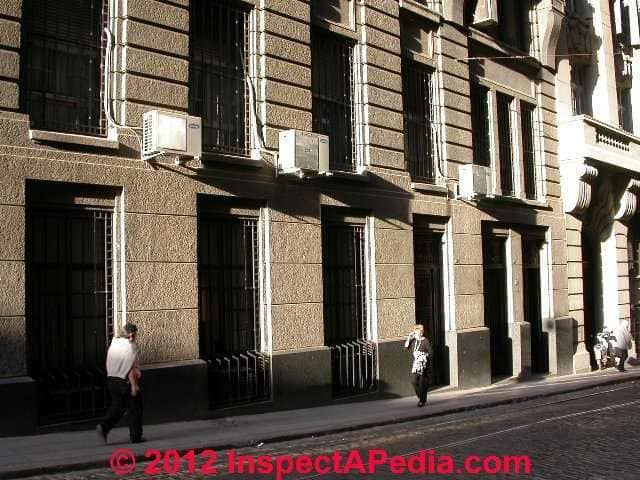
Watch out: inadequately-supported outdoor window air conditioners or inadequately-supported wall-mounted outdoor compressor/condenser units (referred to as the "inverter unit" in some literature) pose a potentially fatal hazard should one of these units fall from the building onto someone below.
Photo above: at this Buenos Aires Argentina building split system A/C condensers are supported by brackeets bolted to the building's exterior wall. Ladders and/or scaffolding will be needed to service these units unless the worker is going to hang outside of a building's window!
The supports are fine but service will be a bear.
Details about the need to support window, through wall, or wall-mounted air conditioning & heat pump equipment are found
How to diagnose & fix weak air flow from a split system air conditioner or heat pump
Fujitsu provides some helpful advice about troubleshooting weak air flow from the indoor wall-mounted component of a split system air conditioner or heat pump. The following are adapted from that source: [9]
Causes of no air flow or very very weak air flow from the A/C - heat pump unit
- Air flow may stop completely under some circumstances. For example, when Heating operation is started, fan speed is temporarily very low, to allow internal parts to warm up.
- During Heating operation, if the room temperature rises above the thermostat setting, the outdoor unit will stop, and the indoor unit will operate at very low fan speed.
If you wish to warm the room further, set the thermostat for a higher setting. - During Heating operation, the unit will temporarily stop operating (between 7 and 15 minutes) as the Automatic Defrosting mode operates.
During Automatic Defrosting operation, the OPERATION indicator lamp will flash.
Causes of weak air flow from the wall-mounted split system A/C or heat pump
- The fan may operate at very low speed during Dry operation or when the unit is monitoring the room's temperature.
- During SUPER QUIET operation, the fan will operate at very low speed.
- In the monitor AUTO operation, the fan will operate at very low speed.
Also check
- For dirty air filters in the wall mounted unit.
- See Split System Air Conditioner Air Filter Maintenance in the article above. You'll have to pull out the air filters to see their condition.
- For dirt and debris blocking the wall unit's air intake grille or outlet grille. You will see this problem by simple visual inspection.
How to diagnose poor or inadequate cooling or heating from a split system air conditioner or heat pump
- If the split system air conditioner or heat pump wall mounted unit is operating but air flow output is weak check the symptoms and fixes listed
at How to DIAGNOSE WEAK AIR FLOW from a SPLIT SYSTEM AIR CONDITIONER or HEAT PUMP - Check that there is no open window or door to the room where the unit is mounted
- Check that the room thermostat or remote control thermostat is calling for cooling (or heating)
- that is, the thermostat or remote control must be set below the current room temperature for the unit to cool, or above the current room temperature for the unit to deliver heat. - In cooling mode, is there a lot of solar gain in the room - say from much direct sunlight through windows?
The heat gain may be exceeding the unit's cooling capacity. If you feel air output from the unit is flowing freely and is cooler than room air (by 10 degrees or more) we suspect this may be the problem.
A room occupied by many people may also be overloading the system as may something really foolish like running a separate heater (check for electric baseboard heat being left "on" for example). - If the unit is in SUPER QUIET mode (or equivalent for other manufacturers) then the unit's fan will be operating in slow mode and may be unable to keep up with the cooling or heating load in the room. Return the system to full AUTO mode instead.
Reader Question: Inoperative split system air conditioner problem traced to control wiring error
I have a White Westinghouse split unit a/c in my villa - one twin fan 2xcompressor outside unit driving 4xinternal units. 3 units work ok. The 4th doesnt cool or heat even after I changed the indoor control unit. All internal votages match other working units.
Tried it on heat just now (room temp 19 selected heat 25)and observed the indoor fan not starting and the evaporator coils icing over. please advise me of the likely causes and test/isolation procedure. Thanks - (Dec 19, 2014) mike
Reply: Mike traces problem to swapped "start" and "reversing" control wires on heat pump / AC
Mike check wiring connections, control board, relays and check for mis-wiring of the controls.
(Dec 19, 2014) Mike said:
Thanks DJF have wiring sched and am working thro it - will feedback.I have pics of the outside unit if you want them.
(Dec 29, 2014) Mike
Hi - joy, and a happy New Year to one and all - we have fixed the problem - many and considerable thanks.
The actual problem appears to have been a simple reversal of the 'start' and 'reversing' control wires betwen the Internal and External units.
That is why nothing happened on cooling (only the RV wire was enabled) and frosting of the evaporator occured on heating (both control wires enabled but, for some reason to do with the o/s PCB, none of the fans kicked in - I surmise this has to do with ampages which I havn't measured).
The original Outside coloured 5 wire is (persumably) short and connected to 5 grey wires somewhere in the wall space which are then presented to the iternal unit (that's the Spanish Building trade for you!!)
the two'experts' I had in earlier in 2014 failed to pick this up and reported the control panel to be faulty recommending new units - which in fairness would have been cheaper than paying them T&M to trawl through the wiring schedules which has been quite time consuming.
I have also hosed out and cleaned all of the units, changed the start/run capacitors and cleaned the filters.
I am now considering adding to my 20 hours of HVAC training on UTUBE by purchasing a set of pressure gauges and completing my amateur maintenance work, although I would have to find a decent HVAC engineer to do any refrigerent related work - any one fancy a week's holiday in Spain :)
I'm of now to redraw my schematics for future reference - Thanks for your encouragement and pointers.
(a much warmer) MikeReply:
Thanks for the feedback-Mike, it will surely help other readers.
Rheem Split AC M#SAKB.065.NAS compressor failure and icing problems.
We Got Rheem Split AC M#SAKB.065.NAS, While It was Operating Properly ,Last Month Compressor Was Grounded, We replaced the same model compressor,
Nitrogen Flush flush, Vaccum, changed the Liquid line filter Drier and charged the R22, It run Normally for a month,
Now the evaporator got full of ice, blocking air flow, so, we run the system in FAN Mode for 2 hrs and ice was gone,
so we checked air filter and evaporator coil and clean with Water, and we installed manifold guage and Ampere meter and run the unit, the high side pressure was 150 psi low side fluctuate 15-30 psi within 40-50 sec, and ampere was 6A ,
while same model other unit were taking 8A ampere and also I noticed as system was on in expansion device ice started to form and slowly to the distributor pipe of evaporator coil, what can we do ? - 13 Jan 2015 Rai , K
Reply:
Rai
Check for low refrigerant level or a sticking thermostatic expansion valve
Convert a Split System Air Conditioner to a Heat Pump System?
Is it possible and about how much would it cost to convert a sanyo single zone ks2472 system to a heat pump system? - Reader Question: 8/2/2014 Roy Brown said:
Reply:
Roy, the Sanyo system you cite, is described by its manufacturer and vendors as follows:
Sanyo 24KS72 24,200 BTU Single Zone Wall-Mounted Cool Only Ductless Split System with DC Inverter, Microprocessor Controls and Wireless Remote Control (KS2472/CSKS24NKU Indoor/ C2472/CUKS24NKU Outdoor)
This unit is designed to operate in 3 modes: Dry (dehumidifies), Cooling, and Fan (just circulates air); as it does not provide a heating mode, this is an air conditioner, not a heat pump.
Heat pumps add certain controls such as a REVERSING VALVE on HEAT PUMPS to reverse the direction of refrigerant flow, and indoor controls to swap from cooling to heating mode.
Most likely you'd need to replace the whole system rather than to try to retrofit parts and controls where they were not intended.
Sanyo does sell a very similar system to yours that IS a heat pump - thus capable of providing heating in cold weather, model
24KHS72 in these capacities
Cooling: 24,200 (4,000~24,200)
Heating: 29,000 (4,400~29,000)You can confirm this with Sanyo at:
SANYO Fisher Service Company
A Division of SANYO North America Corporation
1165 Allgood Road, Suite 22, Marietta, GA 30062 U.S.A
or in Canada
Sanyo Canada Inc.
1-300 Applewood Crescent, Concord, Ontario L4K 5C7, CANADAContinuing for Roy- here you can see that both indoor and outdoor components of the Sanyo AC split system are different from the indoor and outdoor components of the Sanyo Heat Pump split system
Sanyo Split System for |
Sanyo Split System |
||
| Indoor Unit | Outdoor Unit | Indoor Unit | Outdoor Unit |
| KS1872 | C1872 CL1872 |
KHS1872 | CH1872 |
| KS2472 | C2472 CL2472 |
KHS2472 | CH2472 |
Notes to the table above
Source: http://us.sanyo.com/HVAC-Multi-Split-Systems retrieved 8/2/2014 Panasonic USA
So you see the components are different and are not matched - supporting my surmise that you'd need to replace the entire system.
Incidentally the Sanyo 24KLS72 is a discontinued model.
Current price quotes range for the Sanyo Split system heat pump KHS2472 range from about $1800 to $3500 U.S.
...
...
Continue reading at SPLIT SYSTEM AC / HEAT PUMP REPAIRS or select a topic from the closely-related articles below, or see the complete ARTICLE INDEX.
Or see SPLIT SYSTEM AIR CONDITIONERS & HEAT PUMP FAQs - questions and answers posted originally on this page
Or see these
Recommended Articles
- COMPRESSOR / CONDENSER REPAIR
- CONTROLS for Split System (Ductless) Air Conditioner Thermostats & Operating Controls
- DIAGNOSTIC GUIDE A/C or HEAT PUMP
- DIAGNOSTIC DETAILS A/C or HEAT PUMP
- MANUALS & PARTS GUIDES - HVAC - home - Master Index to All Brand Names & HVAC manuals, wiring diagrams, installation and repair guides
- REMOTE CONTROL THERMOSTAT FIX or REPLACE for an air conditioners or heat pump
- SPLIT SYSTEM AIR CONDITIONERS & HEAT PUMPS - home
- SPLIT SYSTEM AC / HEAT PUMP REPAIRS
- SUPPORT SAFETY WARNING for Wall-Mounted Exterior Air Conditioner / Heat Pump Compressor/Condenser Units or Window Air Conditioner Units
Suggested citation for this web page
SPLIT SYSTEM DUCTLESS AIR CONDITIONERS / HEAT PUMPS at InspectApedia.com - online encyclopedia of building & environmental inspection, testing, diagnosis, repair, & problem prevention advice.
Or see this
INDEX to RELATED ARTICLES: ARTICLE INDEX to AIR CONDITIONING & HEAT PUMPS
Or use the SEARCH BOX found below to Ask a Question or Search InspectApedia
Ask a Question or Search InspectApedia
Questions & answers or comments about split system air conditioner operation, installation, maintenance, & repair
Try the search box just below, or if you prefer, post a question or comment in the Comments box below and we will respond promptly.
Search the InspectApedia website
Note: appearance of your Comment below may be delayed: if your comment contains an image, photograph, web link, or text that looks to the software as if it might be a web link, your posting will appear after it has been approved by a moderator. Apologies for the delay.
Only one image can be added per comment but you can post as many comments, and therefore images, as you like.
You will not receive a notification when a response to your question has been posted.
Please bookmark this page to make it easy for you to check back for our response.
IF above you see "Comment Form is loading comments..." then COMMENT BOX - countable.ca / bawkbox.com IS NOT WORKING.
In any case you are welcome to send an email directly to us at InspectApedia.com at editor@inspectApedia.com
We'll reply to you directly. Please help us help you by noting, in your email, the URL of the InspectApedia page where you wanted to comment.
Citations & References
In addition to any citations in the article above, a full list is available on request.
- Eric Galow, Galow Homes, Lagrangeville, NY. Mr. Galow can be reached by email: ericgalow@gmail.com or by telephone: 914-474-6613. Mr. Galow specializes in residential construction including both new homes and repairs, renovations, and additions.
- [2] Modern Refrigeration and Air Conditioning, A. D. Althouse, C.H. Turnquist, A. Bracciano, Goodheart-Willcox Co., 1982
- [3] Principles of Refrigeration, R. Warren Marsh, C. Thomas Olivo, Delmar Publishers, 1979
- [4] "Air Conditioning & Refrigeration I & II", BOCES Education, Warren Hilliard (instructor), Poughkeepsie, New York, May - July 1982, [classroom notes from air conditioning and Refrigerationand Air Conditioning Technology, 5th Ed., William C. Whitman, William M. Johnson, John Tomczyk, Cengage Learning, 2005, ISBN 1401837654, 9781401837655 1324 pages
- [5] "Falling Air-Conditioners Rattle Tenants", Chris Palmer, The New York Times, 2 July 2012, p. A12.
- [7] Singer brand HVAC equipment brand history: Singer was bought by & became the climate control unit of Dallas-based Snyder General Corp. (founded by a former Singer HVAC manager) in 1982.
The name Singer was dropped in 1984. In 1984 Snyder General operations included Arcoaire, Comfortmaker, and McQuay.
In 1991 Snyder General sold Arcoaire & Comfortmaker to Inter-City Products. In 1994 Snyder General was acquired by Hong Leong Group Malaysia. Snyder General is at 2001 Ross Avenue Dallas, TX 75201. - [8] Lennox air conditioning and heat pump owners manuals for air conditioners, air handlers, furnaces, heat pumps, indoor air quality systems, packaged units, water heaters, zone controls and other controls such as thermostats, are provided by Lennox at http://www.lennox.com/support/manuals.asp
- [9] Troubleshooting Split System A/C or Heat Pump Noises, Fujitsu General America, Inc., 353 Route 46 West, Fairfield, NJ 07004, Tel: (888) 888-3424, Tel-Service hotline: (866) 952-8324, Email: hvac@fujitsugeneral.com, Email service: servicehvac@fujitsugeneral.com , retrieved 8/30/12, original source: http://www.fujitsugeneral.com/troubleshooting.htm [copy on file as Troubleshooting Fujitsu Ductless Mini-Splits.pdf]
- [10] Fujitsu Room Air Conditioner, Wall Mounted Type, Heat & Cool Model (Reverse Cycle) [Heat pump units] Operating Manual, Models: ASU18RLXS ASU24RLXS ASU30RLX (indoor & outdoor units). Fujitsu General America, Inc., 353 Route 46 West, Fairfield, NJ 07004, Tel: (888) 888-3424, Tel-Service hotline: (866) 952-8324, Email: hvac@fujitsugeneral.com, Email service: servicehvac@fujitsugeneral.com , retrieved 8/30/12, original source: http://www.fujitsugeneral.com/PDF_06/OperationManual/%28OM%29ASU18-24RLX-30RLX.pdf [copy on file as FujitsuASU18-24RLX-30RLX.pdf]
- In addition to citations & references found in this article, see the research citations given at the end of the related articles found at our suggested
CONTINUE READING or RECOMMENDED ARTICLES.
- Carson, Dunlop & Associates Ltd., 120 Carlton Street Suite 407, Toronto ON M5A 4K2. Tel: (416) 964-9415 1-800-268-7070 Email: info@carsondunlop.com. Alan Carson is a past president of ASHI, the American Society of Home Inspectors.
Thanks to Alan Carson and Bob Dunlop, for permission for InspectAPedia to use text excerpts from The HOME REFERENCE BOOK - the Encyclopedia of Homes and to use illustrations from The ILLUSTRATED HOME .
Carson Dunlop Associates provides extensive home inspection education and report writing material. In gratitude we provide links to tsome Carson Dunlop Associates products and services.


